Seismic Performance of Pile Groups under Liquefaction-Induced Lateral Spreading: Insights from Advanced Numerical Modeling
Abstract
:1. Introduction
2. Numerical Analysis Description
2.1. Problem Definition
2.2. Details of Numerical Modeling
3. Model Validation
3.1. Model Parameter Calibration
3.2. Comparison of Soil–Pile Response in Liquefiable Horizontal Site
3.3. Comparison of Soil–Pile Response in Liquefiable Sloping Site
4. Numerical Results and Discussion
4.1. Soil Response
4.1.1. Liquefaction Process and Excess Pore Water Pressure Development
4.1.2. Soil Displacement
4.2. Structural Response
4.2.1. Pile Displacement
4.2.2. Dynamic Soil Pressure
4.2.3. Dynamic Friction Resistance
4.2.4. Pile Axial Force
4.2.5. Pile Bending Moment
4.2.6. Pile Shear Force
4.3. Cap and Superstructure Response
4.3.1. Cap Rotational Deformation
4.3.2. Cap and Superstructure Horizontal Displacement
5. Conclusions
Author Contributions
Funding
Data Availability Statement
Acknowledgments
Conflicts of Interest
References
- Bhattacharya, S.; Tokimatsu, K.; Goda, K.; Sarkar, R.; Shadlou, M.; Rouholamin, M. Collapse of Showa Bridge during 1964 Niigata Earthquake: A Quantitative Reappraisal on the Failure Mechanisms. Soil Dyn. Earthq. Eng. 2014, 65, 55–71. [Google Scholar] [CrossRef]
- Fujino, Y.; Hashimoto, S.; Abe, M. Damage Analysis of Hanshin Expressway Viaducts during 1995 Kobe Earthquake. I: Residual Inclination of Reinforced Concrete Piers. J. Bridge Eng. 2005, 10, 45–53. [Google Scholar] [CrossRef]
- Yu, J.; Yong, P.; Read, S.; Brabhaharan, P.; Foon, M. The Ms 8.0 Wenchuan Earthquake of 12 May 2008 Reconnaissance Report. Bull. New Zealand Soc. Earthq. Eng. 2010, 43, 41–83. [Google Scholar] [CrossRef]
- Moss, R.E.S.; Kayen, R.E.; Tong, L.-Y.; Liu, S.-Y.; Cai, G.-J.; Wu, J. Retesting of Liquefaction and Nonliquefaction Case Histories from the 1976 Tangshan Earthquake. J. Geotech. Geoenviron. Eng. 2011, 137, 334–343. [Google Scholar] [CrossRef]
- Bian, W.; Wu, J.; Lei, B.; Zhang, L.; Liang, H. Detection of Pre-Seismic Deformation of 2021 Maduo M7.4 Earthquake by Using ASF HYP3. In Proceedings of the IET International Radar Conference (IRC 2023), Chongqing, China, 1 December 2023; pp. 4178–4182. [Google Scholar] [CrossRef]
- Joque, D.T.; Huggins, M.; Rusten, A. Design/Build Delivery of the Schnitzer Steel Wharf and Seawall, Tacoma, Washington. In Proceedings of the Ports ’01; American Society of Civil Engineers: Norfolk, VA, USA, 27 April, 2001; pp. 1–10. [Google Scholar]
- Rashid, M.; Kabir, M.d.R.; Ibne Zaman, M.M. Padma Bridge in Global Media and Boost to SDGs in Bangladesh. J. Media 2023, 4, 445–466. [Google Scholar] [CrossRef]
- Brauer, S.A. Damage Identification of an Offshore Wind Turbine Jacket Support Structure. Master’s Thesis, Norwegian University of Science and Technology, Trondheim, Norway, 2014. [Google Scholar]
- Wang, Y.; Orense, R.P. Numerical Analysis of Seismic Performance of Inclined Piles in Liquefiable Sands. Soil Dyn. Earthq. Eng. 2020, 139, 106274. [Google Scholar] [CrossRef]
- Berrill, J.B.; Christensen, S.A.; Keenan, R.P.; Okada, W.; Pettinga, J.R. Case Study of Lateral Spreading Forces on a Piled Foundation. Géotechnique 2001, 51, 501–517. [Google Scholar] [CrossRef]
- Chen, T. Centrifuge Test and Numerical Study on the Seismic Behavior of Batter Pile Foundation in Lateral Spreading Soil. Master’s Thesis, Tsinghua University, Beijing, China, 2018. [Google Scholar]
- Kastranta, G.; Gazetas, G.; Tazoh, T. Performance of Three Quay Walls in Maya Wharf: Kobe 1995. In Proceedings of the 11th European Conference on Earthquake Engineering, Paris, France, 6–11 September 1998; Volume Topic TS3. [Google Scholar]
- Seed, R.B.; Dickenson, S.E.; Idriss, I.M. Principal Geotechnical Aspects of the 1989 Loma Prieta Earthquake. Soils Found. 1991, 31, 1–26. [Google Scholar] [CrossRef]
- Li, Z.; Escoffier, S.; Kotronis, P. Centrifuge Modeling of Batter Pile Foundations under Earthquake Excitation. Soil Dyn. Earthq. Eng. 2016, 88, 176–190. [Google Scholar] [CrossRef]
- Rajeswari, J.S.; Sarkar, R. Seismic Behavior of Batter Pile Groups Embedded in Liquefiable Soil. Earthq. Eng. Eng. Vib. 2021, 20, 583–604. [Google Scholar] [CrossRef]
- Rajeswari, J.S.; Sarkar, R. Adequacy of Batter Piles under Seismic Conditions: A Review of Past Performances and Investigations. Structures 2024, 61, 106022. [Google Scholar] [CrossRef]
- Giannakou, A.; Gerolymos, N.; Gazetas, G.; Tazoh, T.; Anastasopoulos, I. Seismic Behavior of Batter Piles: Elastic Response. J. Geotech. Geoenvironmental Eng. 2010, 136, 1187–1199. [Google Scholar] [CrossRef]
- McManus, K.; Turner, J.; Charton, G. Inclined Reinforcement to Prevent Soil Liquefaction. In Proceedings of the Annual NZSEE Technical Conference, Wairakei, New Zealand, 11 March 2005; pp. 11–13. [Google Scholar]
- Motamed, R.; Towhata, I.; Honda, T.; Tabata, K.; Abe, A. Pile Group Response to Liquefaction-Induced Lateral Spreading: E-Defense Large Shake Table Test. Soil Dyn. Earthq. Eng. 2013, 51, 35–46. [Google Scholar] [CrossRef]
- Kayalvizhi, S.K.; Muthukkumaran, K.; Shukla, S.K. Experimental Study on Evaluating the Lateral Load Capacity of Raker Pile in Sloping Ground. Aust. J. Civ. Eng. 2023, 21, 20–33. [Google Scholar] [CrossRef]
- Tazoh, T.; Sato, M.; Jang, J. Centrifuge Tests on Pile Foundation-Structure Systems Affected by Liquefaction-Induced Soil Flow after Quay Wall Failure. Doboku Gakkai Ronbunshuu A 2010, 66, 133–147. [Google Scholar] [CrossRef]
- Pan, R.; Xu, C.; Jia, K.; Dou, P.; Kamran, I. Large-Scale Shaking Table Test and Three-Dimensional Numerical Simulation Research on Earthquake Seismic Failure Response of Laterally Spreading Site-Pile Group-Superstructure System. Bull Earthq. Eng. 2023, 21, 4789–4819. [Google Scholar] [CrossRef]
- Li, Z.; Escoffier, S.; Kotronis, P. Centrifuge Modeling of Batter Pile Foundations under Sinusoidal Dynamic Excitation. Bull Earthq. Eng. 2016, 14, 673–697. [Google Scholar] [CrossRef]
- Youd, T.L.; Perkins, D.M. Mapping of Liquefaction Severity Index. J. Geotech. Eng. 1987, 113, 1374–1392. [Google Scholar] [CrossRef]
- Zhu, M.; McKenna, F.; Scott, M.H. OpenSeesPy: Python Library for the OpenSees Finite Element Framework. SoftwareX 2018, 7, 6–11. [Google Scholar] [CrossRef]
- Borgese, P. Numerical Analysis of Half-Joints Subjected to Corrosion and Evaluation of Possible Retrofitting Interventions. Master’s Thesis, Politecnico di Torino, Torino, Italy, 2024. [Google Scholar]
- Desai, C.S.; Zaman, M.M.; Lightner, J.G.; Siriwardane, H.J. Thin-Layer Element for Interfaces and Joints. Int. J. Numer. Anal. Methods Geomech. 1984, 8, 19–43. [Google Scholar] [CrossRef]
- Trapani, F.D.; Bogatkina, V.; Petracca, M.; Camata, G. Evaluation of the Additional Shear Demand Due to Frame-Infill Interaction: A New Capacity Model. Procedia Struct. Integr. 2023, 44, 496–503. [Google Scholar] [CrossRef]
- Ghalibafian, H. Evaluation of the Effects of Nonlinear Soil-Structure Interaction on the Inelastic Seismic Response of Pile-Supported Bridge Piers. Ph.D. Thesis, University of British Columbia, Vancouver, BC, Canada, 2006. [Google Scholar]
- Hussein, A.F.; El Naggar, M.H. Seismic Behaviour of Piles in Non-Liquefiable and Liquefiable Soil. Bull Earthq. Eng. 2021, 20, 77–111. [Google Scholar] [CrossRef]
- Shahir, H.; Mohammadi-Haji, B.; Ghassemi, A. Employing a Variable Permeability Model in Numerical Simulation of Saturated Sand Behavior under Earthquake Loading. Comput. Geotech. 2014, 55, 211–223. [Google Scholar] [CrossRef]
- Chang, D. Inertial and Lateral Spreading Demands on Soil -Pile -Structure Systems in Liquefied and Laterally Spreading Ground during Earthquakes. Ph.D. Thesis, University of California, Davis, CA, USA, 2007. [Google Scholar]
- Dashti, S.; Kirkwood, P. A Centrifuge Study of Seismic Structure-Soil-Structure Interaction on Liquefiable Ground and Implications for Design in Dense Urban Areas. Earthq. Spectra 2018, 34, 1113–1134. [Google Scholar] [CrossRef]
- Ramirez, J.; Barrero, A.R.; Chen, L.; Dashti, S.; Ghofrani, A.; Taiebat, M.; Arduino, P. Site Response in a Layered Liquefiable Deposit: Evaluation of Different Numerical Tools and Methodologies with Centrifuge Experimental Results. J. Geotech. Geoenviron. Eng. 2018, 144, 04018073. [Google Scholar] [CrossRef]
- Xu, C.; Dou, P.; Du, X.; El Naggar, M.H.; Miyajima, M.; Chen, S. Large Shaking Table Tests of Pile-Supported Structures in Different Ground Conditions. Soil Dyn. Earthq. Eng. 2020, 139, 106307. [Google Scholar] [CrossRef]
- Jia, K.; Xu, C.; El Naggar, M.H.; Zhang, X.; Du, X.; Dou, P.; Cui, C. Large-Scale Shake Table Testing of Pile Group-Bridge Model in Inclined Liquefiable Soils with Overlying Crusts. Soil Dyn. Earthq. Eng. 2022, 163, 107555. [Google Scholar] [CrossRef]
- Zheng, G.; Zhang, W.; Zhou, H.; Forcellini, D.; Zhao, J.; Zhang, T. 3D Numerical Modeling of the Inertial and Kinematic Interactions of Inclined Pile Groups in Liquefiable Soils. Int. J. Geomech. 2024, 24, 04024161. [Google Scholar] [CrossRef]
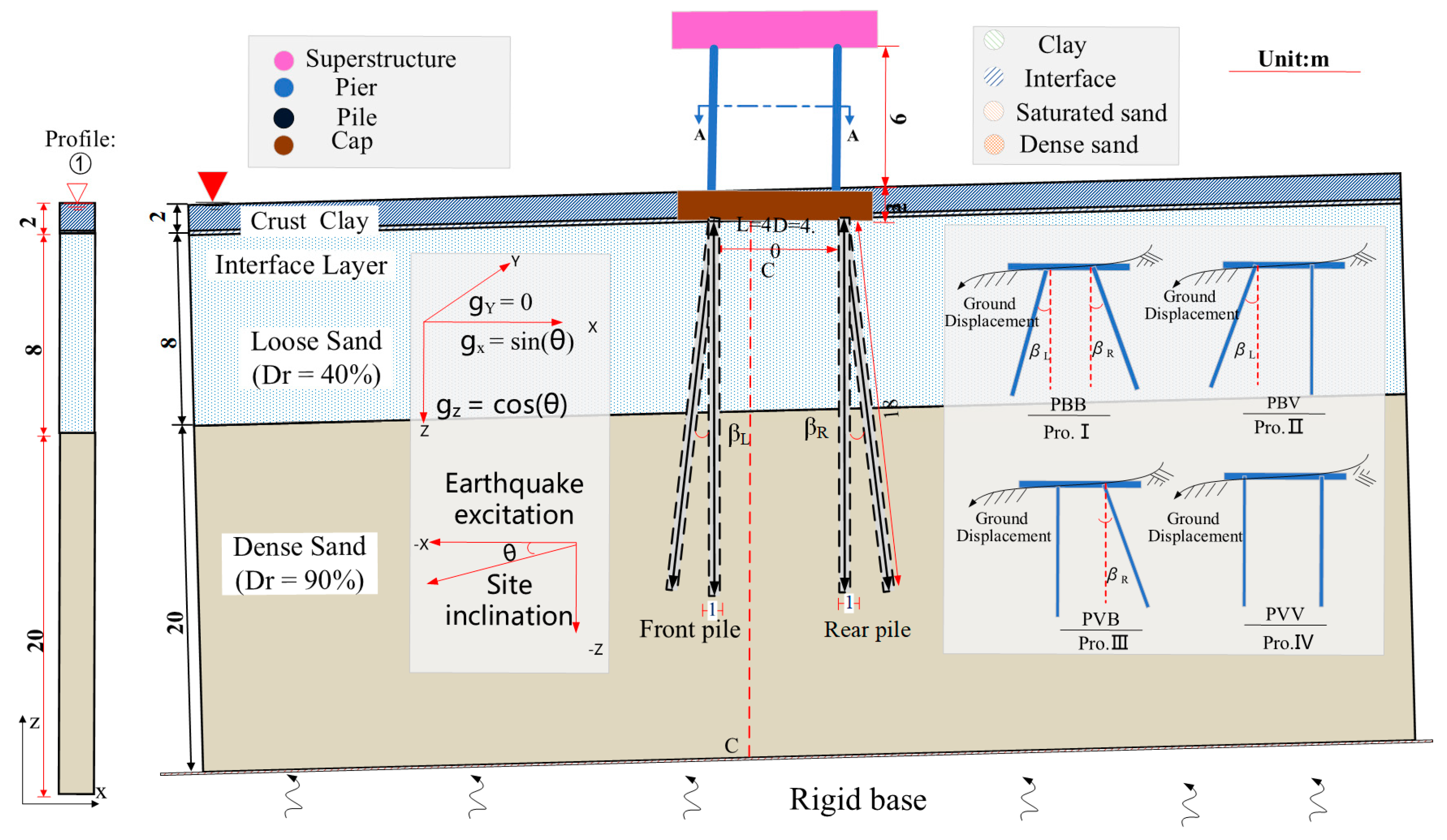

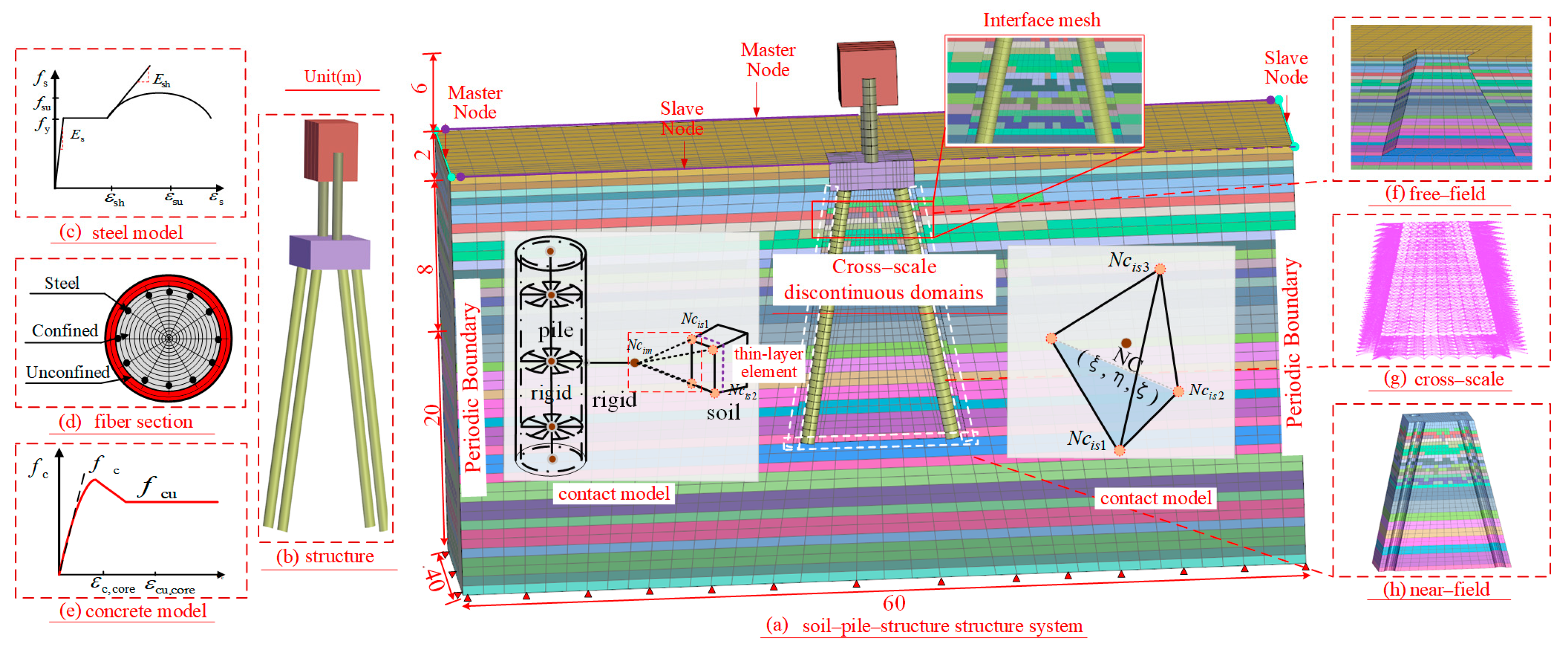

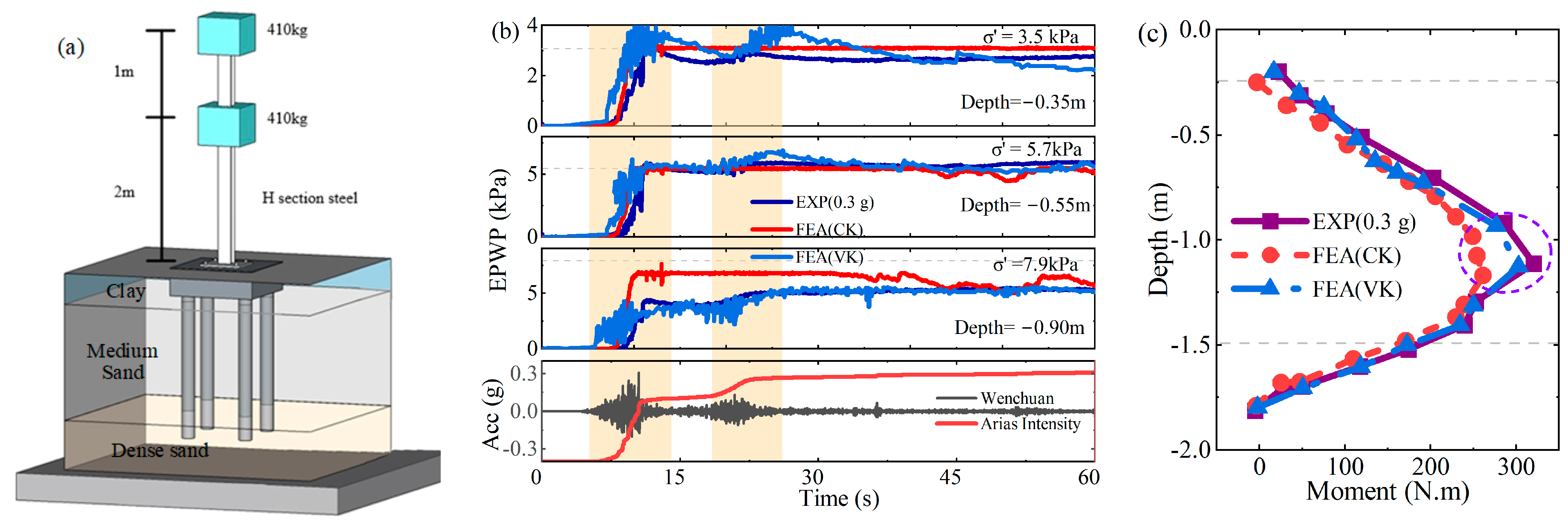
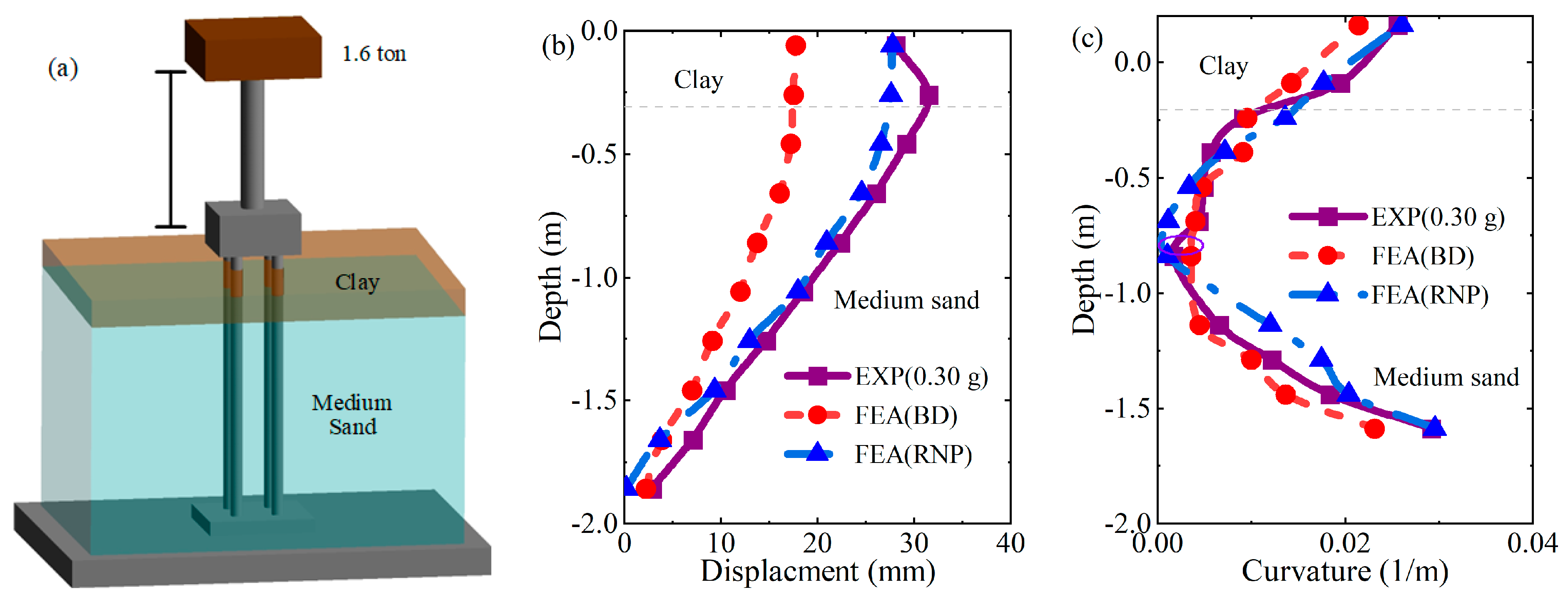

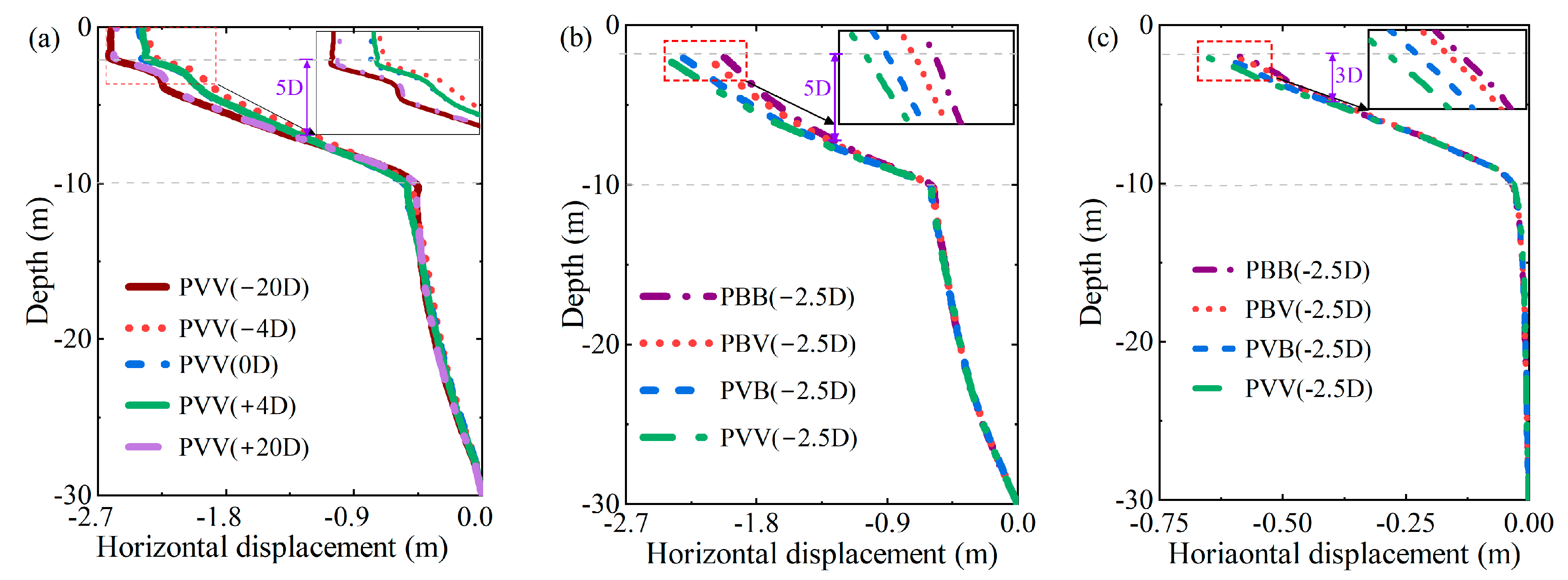




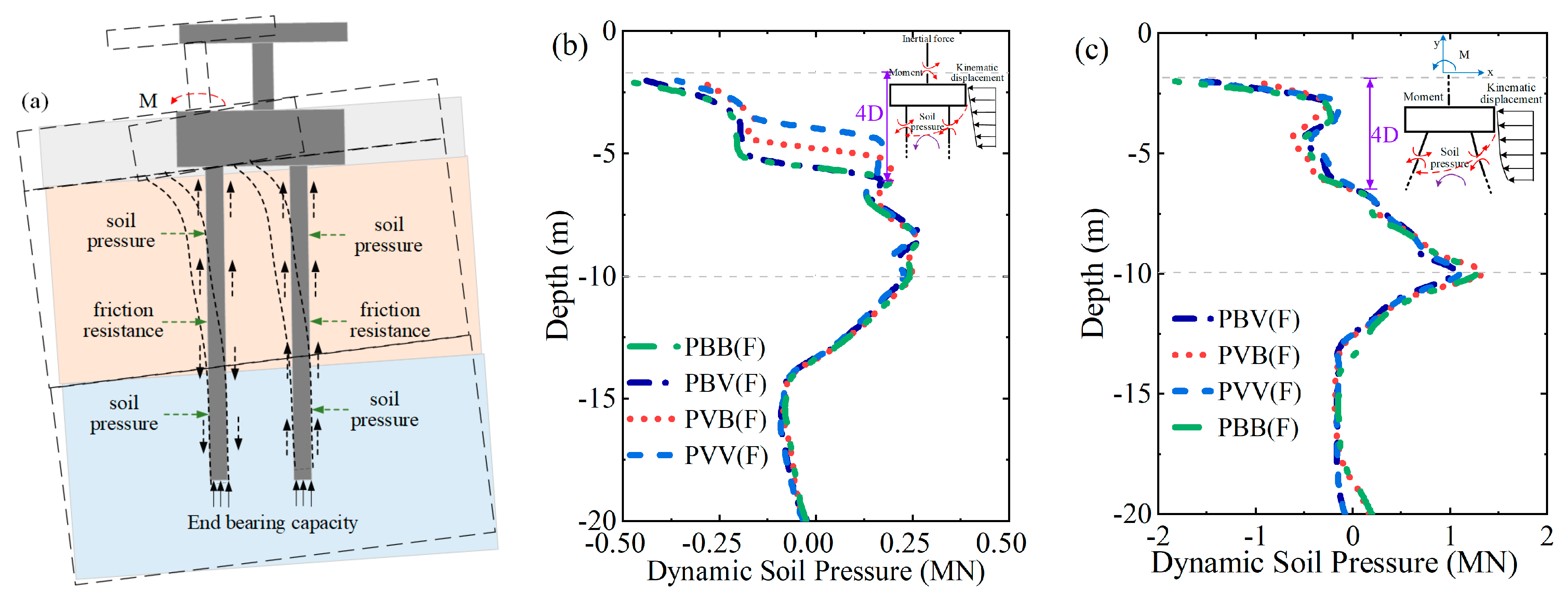

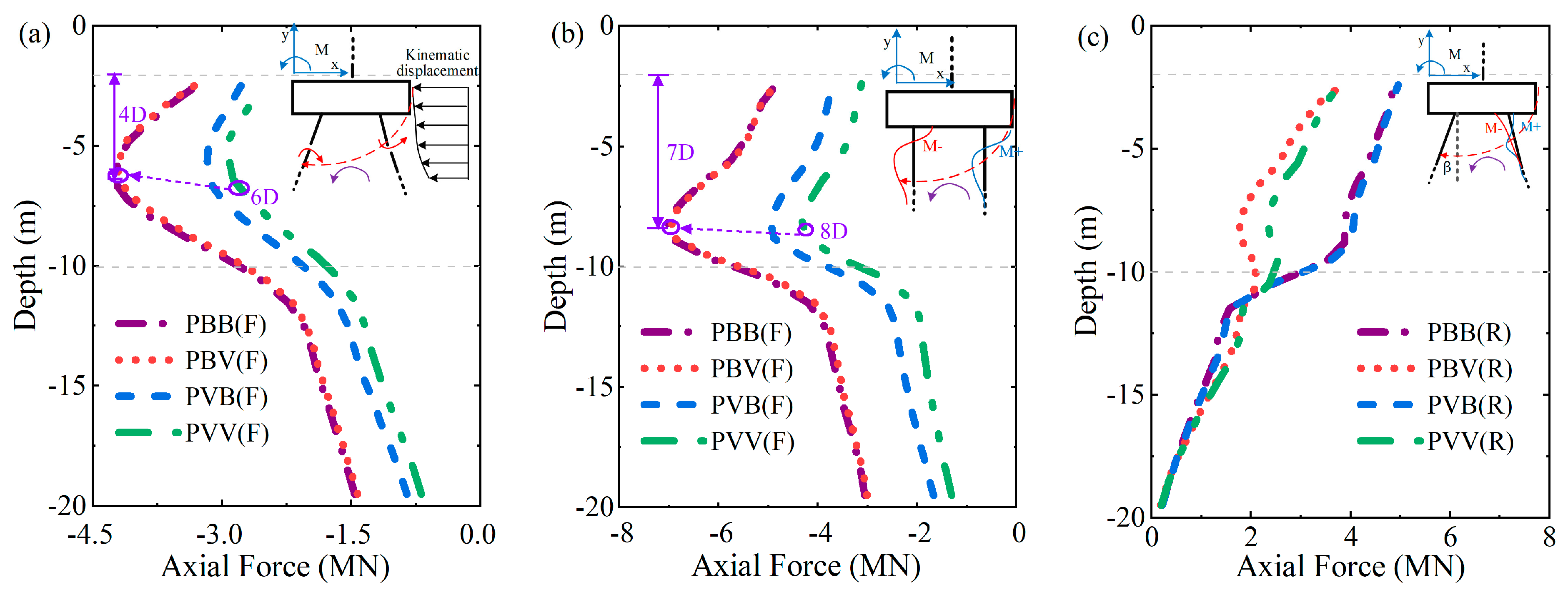
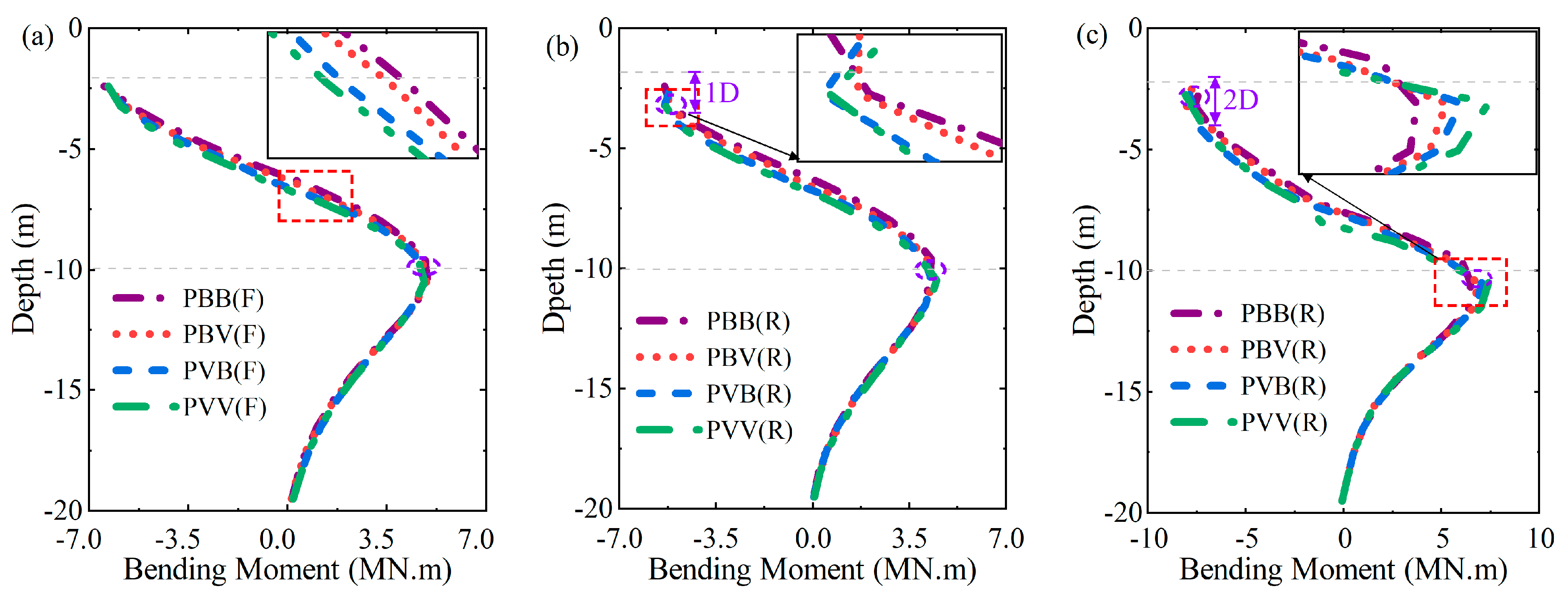
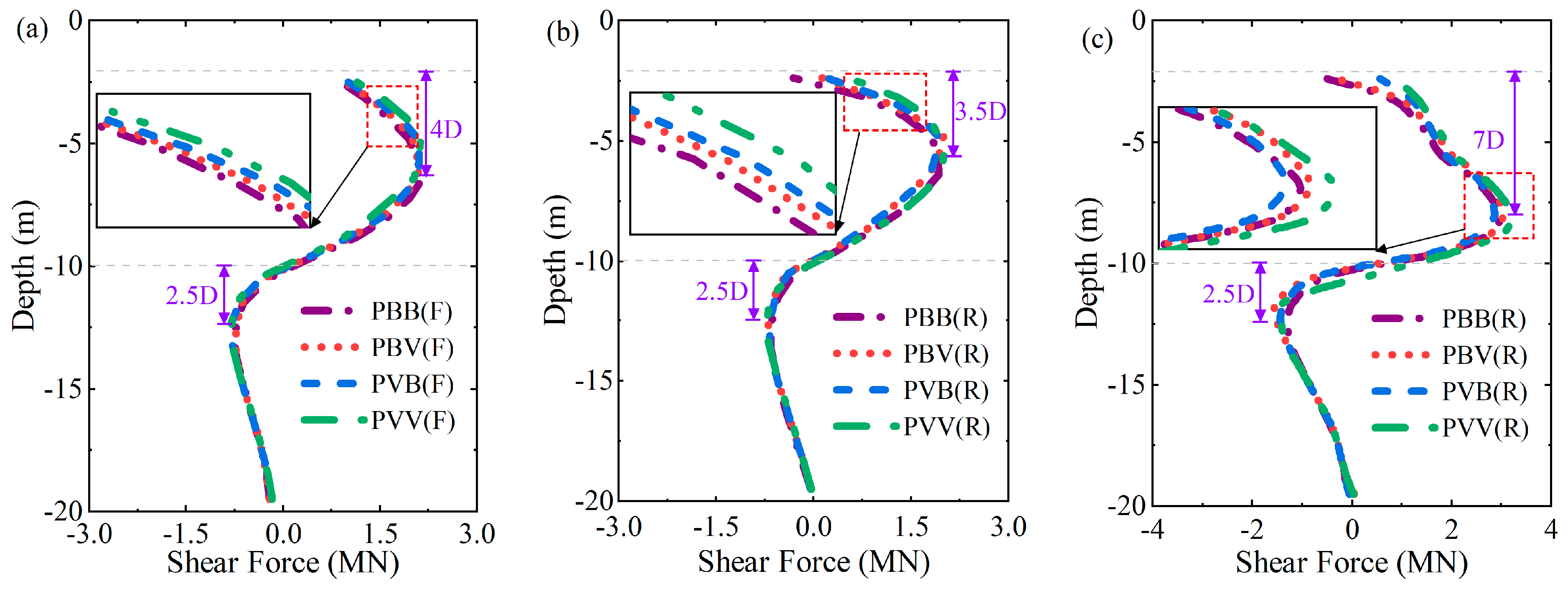


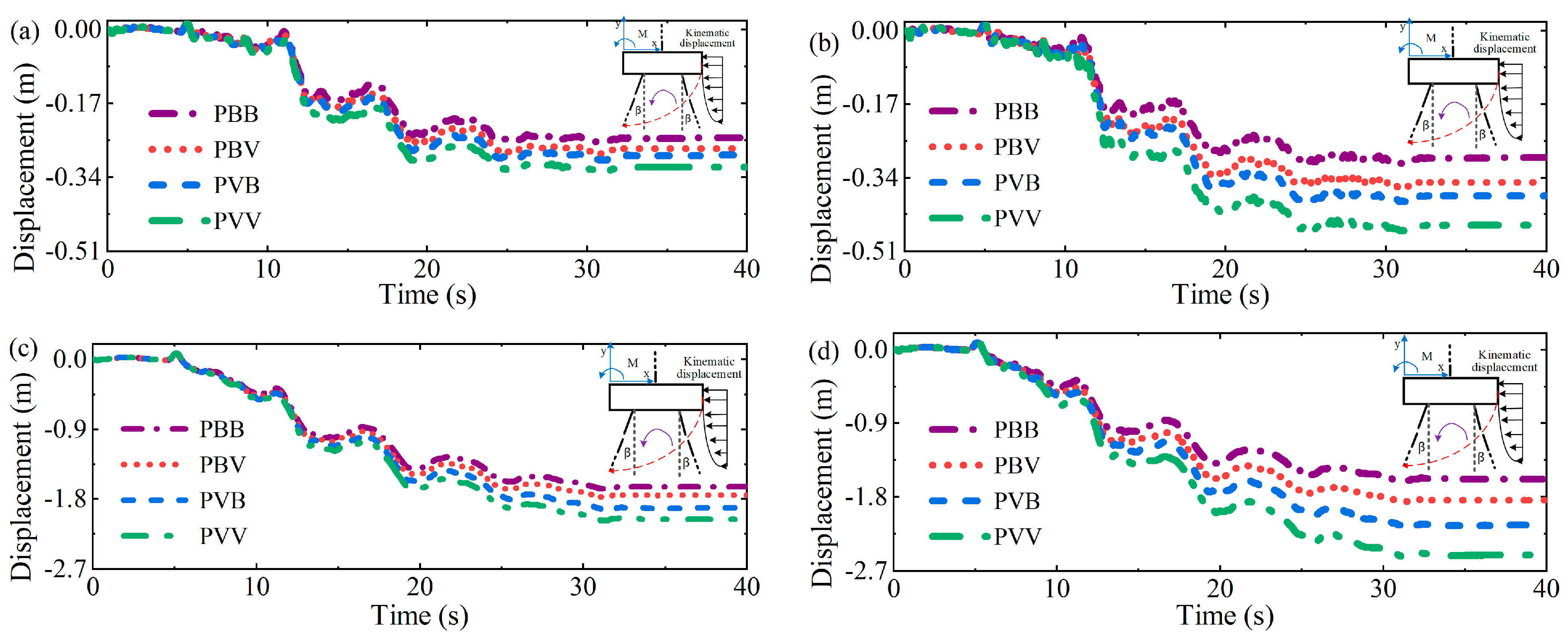
| Parameter | Ottawa Sand | Clay | Description | |
|---|---|---|---|---|
| (%) | 40 | 90 | Relative density | |
| e | 0.70 | 0.55 | Void ratio | |
| (kPa) | 101 | 101 | 101 | Reference effective confining pressure |
| (MPa) | 82 | 105 | 15 | Octahedral small-strain shear modulus |
| 0.1 | 0.1 | 0.1 | Maximum octahedral shear strain | |
| d | 0.5 | 0.5 | 0.5 | Pressure dependency coefficient |
| (degrees) | 31 | 38.5 | - | Triaxial peak friction angle |
| (degrees) | 26.8 | 34 | - | Phase transformation angle |
| 0.61, 3.1, 2.24 | 0.077, 1.25, 1.36 | - | Control shear-induced volumetric change, contraction tendency based on dilation history, and overburden stress effects, respectively. | |
| 0.1, 3.0, 0.27 | 1.13, 3.0, 1.05 | - | Reflect dilation tendency; stress history, d; and overburden stress, respectively. | |
Disclaimer/Publisher’s Note: The statements, opinions and data contained in all publications are solely those of the individual author(s) and contributor(s) and not of MDPI and/or the editor(s). MDPI and/or the editor(s) disclaim responsibility for any injury to people or property resulting from any ideas, methods, instructions or products referred to in the content. |
© 2024 by the authors. Licensee MDPI, Basel, Switzerland. This article is an open access article distributed under the terms and conditions of the Creative Commons Attribution (CC BY) license (https://creativecommons.org/licenses/by/4.0/).
Share and Cite
Pan, R.; Xu, C.; Meite, R.; Chen, J. Seismic Performance of Pile Groups under Liquefaction-Induced Lateral Spreading: Insights from Advanced Numerical Modeling. Buildings 2024, 14, 3125. https://doi.org/10.3390/buildings14103125
Pan R, Xu C, Meite R, Chen J. Seismic Performance of Pile Groups under Liquefaction-Induced Lateral Spreading: Insights from Advanced Numerical Modeling. Buildings. 2024; 14(10):3125. https://doi.org/10.3390/buildings14103125
Chicago/Turabian StylePan, Rujiang, Chengshun Xu, Romain Meite, and Jilong Chen. 2024. "Seismic Performance of Pile Groups under Liquefaction-Induced Lateral Spreading: Insights from Advanced Numerical Modeling" Buildings 14, no. 10: 3125. https://doi.org/10.3390/buildings14103125





